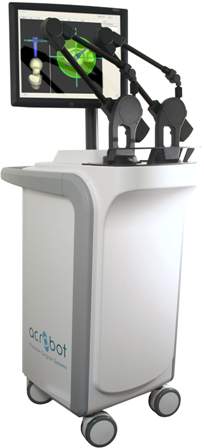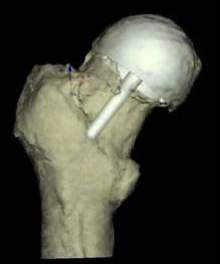Surgical navigation robot improves hip surgery training20 February 2008 A pilot study at Imperial College, London has shown that a surgical navigation robot could improve hip surgery and help end painful repeat hip operations. The new robot, called the Navigation Wayfinder, was developed by Imperial College spin-out Acrobot and UK medical device company Corin Group. It made medical undergraduates three times more accurate during practice hip operations. Professor Justin Cobb, Head of the Biosurgery and Surgical Technology Group at Imperial College London, and co-founder of Acrobot, conducted the trial using 32 undergraduate medical students practising hip resurfacing arthroplasty procedures — a method for correcting painful hip bone deformities by coating the femoral head with a cast of chrome alloy. The pilot study tested whether planning before an operation, combined with the new robot could increase the success rates of students. The operation is technically demanding and requires precision and accuracy. Surgeons rely on years of experience and on different cameras, lasers and hand-held tools to help them navigate during an operation. Inexperienced surgeons often face a steep learning curve to gain the experience necessary to carry out hip resurfacing operations. Until now, this has only been gained through repeatedly performing the operations. This can cause problems because if hip bones are repaired incorrectly wear and tear occurs, requiring patients to undergo further painful and expensive corrective operations.
It has twin digital arms protruding from a console. One senses the movement of surgical tools as they slice through a patient’s hip area. The other takes detailed images of the bones. This information is fed into software which generates a virtual model of a patient’s hip as it is being operated on. Similar to a 3D roadmap, it allows the user to plot the progress of an operation as they are performing it — a vital technique for ensuring that it is being carried out correctly. Professor Cobb saw the benefits of incorporating the Wayfinder into undergraduate training and developed a three-step training programme. Students used model replicas of deformed hip bones for the trial, scanned by the Wayfinder’s digital arm. This information was used to create a 3D virtual model of the bone area. The Wayfinder’s computer programme developed an operation plan setting out the actions required for undergraduates to correct the hip deformity. Students were asked to carry out a virtual operation on the 3D model of the hip. Using the tool tracking arm, they practised techniques for fastening chrome alloy on virtual deformed hip bones. This built up their confidence, technique and skill. They were asked to perform surgery on model casts of real hip bones. By using the Wayfinder to help them navigate, undergraduates were able to attach a post to the centre of the femoral head and thread it, via a guide wire, to the femur.
Professor Cobb then asked students to perform the same operation using conventional navigation tools. One method involved the use of jigs and alignments. Similar to geometry sets, they are metal surgical guides which helped undergraduates to manually align the femoral head as they attached it to the femur. The second method required students to operate using an optical navigation device. A camera and pinpoint lights were used to create an image of the hip on a computer screen. This was used by undergraduates for visual navigation during the procedure. Professor Cobb compared how undergraduates performed with each different method. He found that they were three times more accurate and precise using the Wayfinder than if they used the two other conventional methods. Clinical trials using the Wayfinder are currently being carried out at Warwick Hospital, Bath Hospital, Truro Hospital and the London Clinic. Professor Cobb believes his training method could be applied throughout the UK to improve outcomes for patients. He said: “Our research proves that we can take untrained surgeons and make them an expert in a new technique rapidly. More importantly, we’ve also demonstrated that no patient has to be on an inexperienced surgeon’s learning curve. This could significantly improve a patient’s health and wellbeing and ensure they do not have to undergo repeat operations.” |
 The
Wayfinder (see image on right) navigation system is similar to a GPS
tracking system. It helps the user to navigate during surgery by plotting
correct surgical incisions. It also calculates the correct angles for
inserting chrome alloy parts needed to repair hip bones.
The
Wayfinder (see image on right) navigation system is similar to a GPS
tracking system. It helps the user to navigate during surgery by plotting
correct surgical incisions. It also calculates the correct angles for
inserting chrome alloy parts needed to repair hip bones. 